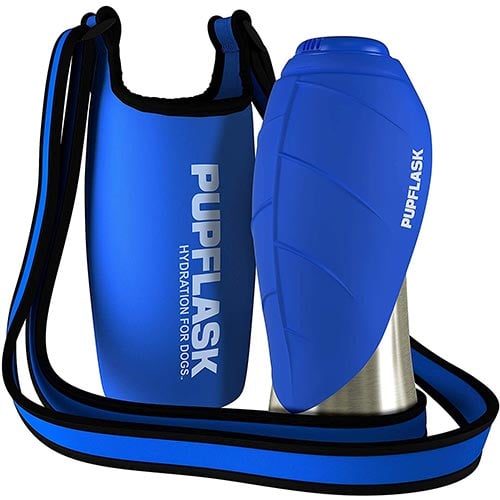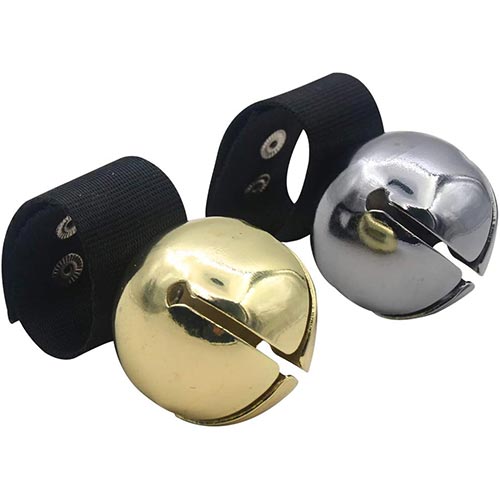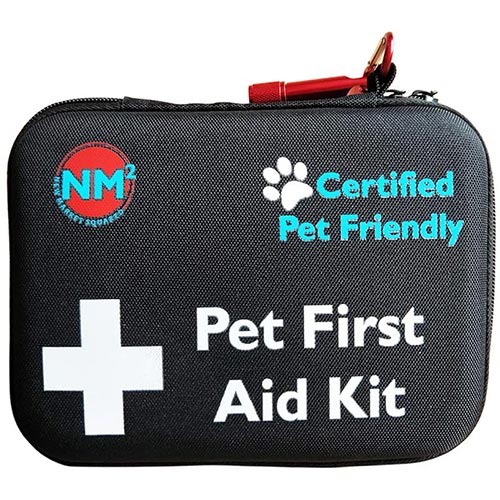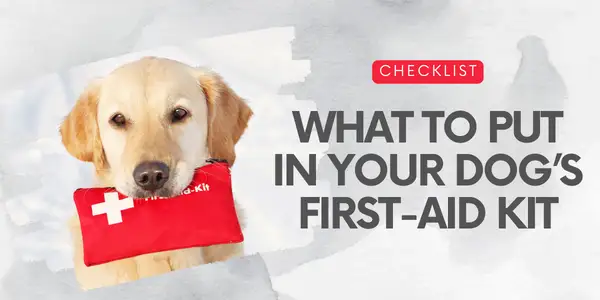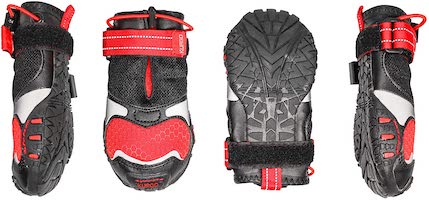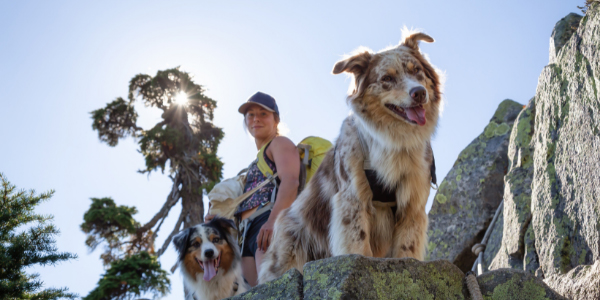 Hiking with your dog is a bonding experience every active dog and dog owner should get to enjoy at some point together.
Hiking with your dog is a bonding experience every active dog and dog owner should get to enjoy at some point together.
Not only is hiking fantastic exercise for you and your pup, but a great way to get outside and enjoy everything nature has to offer.
It's always best to set you and your hiking buddy up for success before you take off for the trail by ensuring your pup is ready for the hike and that you have the right gear. Beyond the prep work and right hiking gear, it's also essential to have some basic training to make your hike safer and more enjoyable for all.
It’s important to plan for possible safety issues while hiking with your dog. Ideally, every hiking trip will go off without a hitch, and as my trail running and hiking friends and I like to say, “We come out with the same injuries we go in with!”
But that isn’t always the case, and the best way to ensure you minimize the risks is to be aware and prepared of what can arise while ‘on trail.’ So here are a few of the more common issues that can and do arise while hiking with dogs and how to avoid them.
Bring Enough Water for Your Dog
Prevent Heatstroke While Hiking
Wildlife Dangers for Dogs
Wildlife Traps
Dog Hiking Injuries
Paw Care on Hikes
Trail Safety Takeaways
Pack Enough Water for Your Dog
Just as when you’re hiking, you get thirsty, so will your dog. It’s essential you provide fresh, clean drinking water for your pooch in addition to the water you pack for yourself. If you don’t provide your pooch with fresh, clean water you may find that they will instead find another water source, such as a pond, stream, or puddle, which can carry extreme parasite and pathogen risks. These water sources are often contaminated with leptospirosis, coccidia, giardia, or other bacterial or intestinal parasites which can make your dog extremely sick.
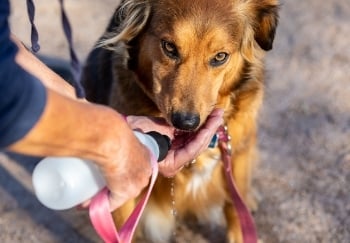 How Much Water to Bring on Hikes for Your Dog
How Much Water to Bring on Hikes for Your Dog
On a normal day, a dog should consume between 1.7 to 3 fluid ounces per 2.2 lbs of body weight (50-90 ml per kg) of water per DAY depending on the size, breed, activity, and many other factors of your particular dog.
When on a hike and performing what may be considered strenuous activity, as well in potentially warmer to hot weather, that amount increases exponentially to close to double when hiking! Pack more water than you think you'll need. It's always better to be safe than sorry when it comes to preventing dehydration and heatstroke.
Two of my favorite dog water bottles for hiking are the PupFlask from Tuff Pupper and the Lesotc Water Bottle with included dispenser.
Preventing Heatstroke while Hiking with Your Dog
Dogs don’t sweat like humans. Instead, panting is their main method to keep cool. A nice breeze on sweaty skin often makes us as humans feel much cooler on a hot hike. However, this is not the same for a hot dog.
Stay aware of how much your dog is panting and if they are stopping frequently for breaks or laying down for a rest while hiking. These are all indicators that your dog may be hot or tired and needs a rest or to cool down. Excess fatigue can be the first sign of heatstroke.
Signs of Heatstroke Include:
- Excessive panting
- Drooling
- Bright red/deep red gum color
Progressing to:
- Vomiting/diarrhea
- Mental dullness
- Uncoordinated movement
- Collapse
- Loss of consciousness
Being aware of these signs and making sure you are taking frequent breaks where you are providing fresh, clean water for your dog will help prevent heatstroke and allow you to complete your hike with a hydrated, happy dog at the end.
Find out more about how to recognize signs of heatstroke and what to do if your dog is suffering from heatstroke here.
 Flat-Faced Dogs are at Higher Risk of Heatstroke While Hiking
Flat-Faced Dogs are at Higher Risk of Heatstroke While Hiking
As cute as they are, brachycephalic – or "smoosh-faced" – dog breeds such as Pugs, English and French Bulldogs, Boxers, etc., are prone to overheating and heatstroke more rapidly than dogs with long snouts. This is because these dogs have all of their facial features squished into a much smaller space, making it harder for them to breathe and making them prone to overheating.
Flat-faced dogs don’t make the best hikers. If you do want to take them hiking, do so during the coolest parts of the day (early in the morning or later in the evening). If they are small enough, carry them in a dog backpack so they are not forced to exercise and increase their body temperature resulting in possible heatstroke. And make sure to slowly condition them to increased physical exercise and longer hikes.
Snake & Wildlife Encounters for Your Dog While Hiking
Before you start out on your hike, make yourself aware of the type of wildlife you could encounter on your trail so you are prepared should you encounter one of these animals.
Dogs are inherently curious, and, while hiking — especially if you are going to allow them to be off-leash (if you are on a trail where this is allowed) — they are going to wander and sniff as this is only natural for them to investigate their surroundings. However, this only makes it easier for them to get into trouble as they don’t know to stay away from dangerous animals such as snakes, scorpions, porcupines, or even bears and often want to engage with them.
Most snake bites on dogs happen around the nose, mouth, and face because the dogs are usually trying to smell and investigate their surroundings. Attaching a bear bell to your dog’s collar so they’re unable to sneak up on an unsuspecting wild animal is a great idea in an attempt to prevent your pup from being bitten or attacked.
The best way to avoid wildlife attacks is to keep your dog on a leash and stick to marked trails. This way you can keep your dog close and avoid having them discover wild animals on their own.
What to Do if Your Dog is Bitten or Attacked While Hiking
If your dog is bitten or attacked by a wild animal while you are out hiking, first you need to make sure you and your dog are safe from continued attack, especially if it is a bear or other wild animal that may come back. Always be prepared on hikes with bear spray and other safety devices.
Ideally, you have a pet first aid kit with you and can address any severe wounds that may be bleeding by cleaning and bandaging them.
If your dog is able to walk and it is not far from your vehicle, then getting to your car ASAP and getting to the closest veterinary hospital is the next best step.
Porcupines & Dogs
If you are an avid hiker, there is a chance at some point you will come across a porcupine in your travels. Therefore, it is recommended you read our article What to Do if a Porcupine Quills Your Dog before you hit the trails so you know what to do in the event your pup is curious enough to get themselves ‘quilled’.
 Snake Bites & Dogs
Snake Bites & Dogs
It is no secret that snakes and hikers share many hiking trails, some peacefully and some not so. Therefore, if your pooch is to come across or interact with a snake and/or is to sustain a bite from one, it is important to follow the following guidelines:
- If the snake was suspected to be venomous, do NOT try to capture the snake – as you could get bitten and/or further aggravate the snake and cause it to bite your dog again.
- Do NOT tie off the region like we’ve been taught in the movies in people, in an attempt to restrict blood flow. Particularly with rattlesnake bites, this could lead to more issues including tissue necrosis (death) due to decreased oxygen to the tissues.
- You should try to keep any bite below the heart if possible. Snake bites towards dogs most typically occur on limbs, making this much easier. However, if a bite is to occur on a muzzle/nose from a curious pup keeping their muzzle below their chest is ideal in an attempt to use gravity to prevent the infected blood from traveling faster towards the heart.
- Next, DO NOT try to suck any venom out. This is an unfortunate misconception generated by TV and movies, but it is not something that is actually possible to do. Similar to administering a vaccine. Once a venom has entered the body, it can’t be removed mechanically.
- Try to keep your dog calm, who may be acting distressed if they didn’t see the snake prior to being bitten and/or due to the pain and/or discomfort of the bite itself. Staying calm yourself can help your dog calm down, as well as speaking in a soothing tone to reassure them.
- Carry your dog – if possible – back to your vehicle to be transported to the closest veterinary facility ASAP for immediate care.
If you hike with your dog frequently in areas with snakes, it's best to work on snake avoidance training prior to hitting the trails. Learn more about how snake avoidance training for dogs works here.
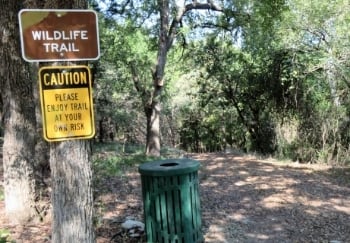 Keeping Your Dog Safe from Wildlife Traps While Hiking
Keeping Your Dog Safe from Wildlife Traps While Hiking
Nowadays, almost all U.S. states have laws regarding who can trap and where and when they are allowed to do so. Unfortunately, not everyone sticks to these rules which results in traps being found close to, if not on, many popular hiking trails. Even legal traps have been found on or near trails.
There are a variety of animal traps, including leg holds and snares, all of which could cause significant trauma should your dog become caught or even, worst case, strangle your dog.
To avoid these types of situations, do your research on the area you’re planning on hiking and know the trapping regulations. This information typically can be found on the state’s park and wildlife department or the fish and game department's website.
However, remember, this won’t indicate placement of illegally laid traps which are typically purposely hidden and baited in order to trap wildlife. So, it’s best to keep Fido on the trail and on a leash to prevent them from wandering. You’re also most likely to encounter traps closer to trailheads and areas with easy access to roads.
If your dog does become caught in a leg hold created for other wild animals such as coyotes or foxes, they are typically designed to do as minimal damage as possible to the ensnared animal's limb. However, your dog may become distressed by the sudden entrapment, requiring you to keep them calm while you contact the Parks and wildlife or similar service.
Unless you know what you are doing, it is not recommended to try and undo a trap yourself, particularly if your dog is distressed. They could bite you out of panic, fear, or pain — even if they typically never bite. If your dog isn’t already on a leash, make sure they are on one before they are freed from the trap, so they don’t run off out of fear and either get caught in another trap or get lost.
Have them seen by a veterinarian immediately after being freed to have the leg assessed for any wounds or damage to the leg, including muscle, tendon, or bone damage that may not be evident from the surface and if they need pain or anti-inflammatory medications.
Dog Hiking Injuries and Wounds
If your dog is to sustain an injury or wound while on a hike, hopefully, you have already prepared by packing a doggie first-aid kit that includes items for you to address a variety of wounds, such as paw pad injuries, scrapes, stick injuries, or scratches. As soon as you notice any wound or injury, you should stop and address it immediately. If the wound appears to be minor, such as a superficial scratch that isn’t bleeding or bleeding very little, then cleaning it with sterile saline and ensuring your dog is comfortable to continue should be fine.
However, if the wound is deeper and appears that it may require stitches or it is bleeding excessively, cleaning the wound, again with sterile saline and in a manner that will enable you to exit the trail and get you back to your vehicle and to a veterinarian ASAP is best.
If your pup has sustained an even more serious injury such as a broken leg, or they are unable to walk on their own, this is a great reason to consider a carryout pack, such as this one from Fido Protection, that allows you to strap your dog to your back to carry them out of the trail in an emergency.
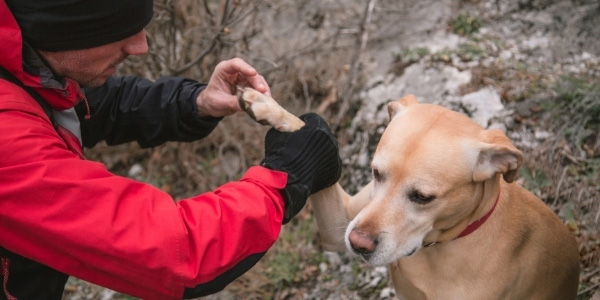 Caring for Your Dog’s Paws While Hiking
Caring for Your Dog’s Paws While Hiking
As mentioned above there are many things on hiking trails that can cause injuries or wounds while hiking. However, paw pad injuries can be caused by things like sharp or hot rocks to low hanging branches, or even cacti.
The best way to avoid these types of injuries to your dog’s paws is to have your pup wear boots specifically designed for hiking or better yet, to condition your pups’ paws to these types of conditions, similar to us walking without shoes. The tougher your dog’s paws become the better they’ll be able to withstand rough trails. However, keep in mind, just like our feet, no paw, no matter how tough or calloused can withstand broken glass, cactus thorns, etc. Learn how to care for your dog's paw pads in this article for more tips.
So once again, making sure you are well aware of the type of terrain you are hiking on before you go and you have packed a specific dog first aid kit in case of injury is imperative.
If your dog does happen to sustain a paw injury while on trail, STOP immediately to assess the extent of the injury or wound and clean the area thoroughly and apply an appropriate dressing from your pet first aid kit. If the wound is open or you think it requires stitches, it is recommended you discontinue your hike and return to your vehicle and institute your emergency veterinary care plan for your dog.
If the wound is superficial, i.e., there is no blood and the wound or injury is not on the base of the paw and therefore won’t get worse with continued movement and your dog is not in pain or discomfort, continuing on the hike should be ok, provided you continue to monitor any and all injuries closely and you stop immediately, should there be any changes or your dog shows any sign of pain or discomfort.
Trail Safety for Dogs: The Takeaways
- It is imperative that you have a pet emergency plan before you go hiking with your dog! In the event that your dog is harmed by another animal, or by any of these on-trail dangers discussed above, it’s essential that you know where the closest emergency veterinary facility is and how to get there. This requires that you do research beforehand, including if you’ll have cellphone service available while hiking.
- Ensure you are prepared with enough water for your dog.
- Have a well-packed dog first aid kit.
- Know your surroundings, location, and terrain.
- Keep your dog on a leash (ideally), or in your eyesight at a minimum and on the trail.
- Be aware of the type of wildlife in the area and the season. Is it winter and bears are hibernating or are they out with their cubs, or are the snakes out, etc.
Having a plan and keeping your eyes peeled on your best-four-legged friend will ensure you have a great time out on the trails together and soaking up all that mother nature has to offer!


